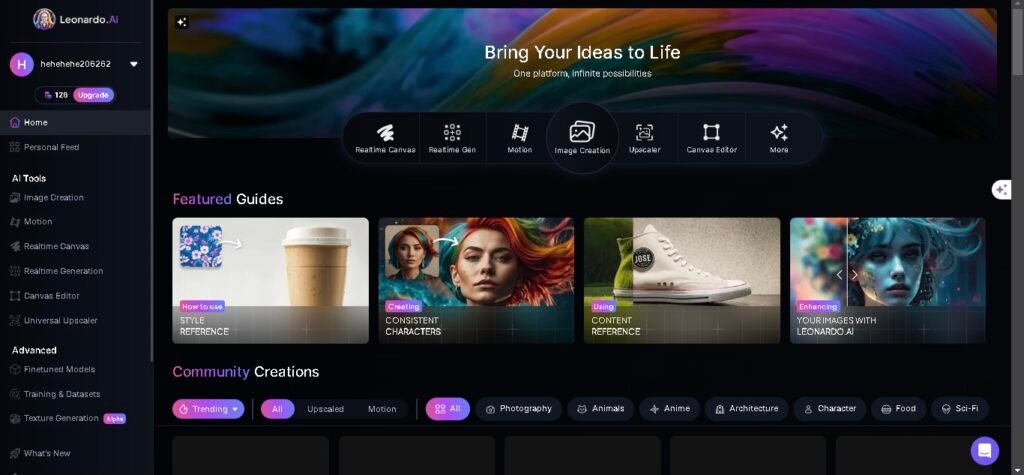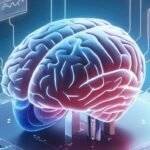Overview
Leonardo Ai It creates realistic, high-quality models and artificial intelligence by applying modern techniques for deep learning and neural networks. Every day, millions of photographs are created by more than 7 million users. Leonardo A.I.
The Key Features
1. Creation of Images:
Text prompts: Users can design images that just represent what they wish to see. After understanding these feelings, the AI paints a precise and comprehensive image.
Pre-trained images: Real light, animation, and cinematic effects are just a few of the forms that may be produced with pre-trained photos from Leonardo AI.
2. Artificial Intelligence Canvas
Editing in real-time: AI Canvas enables users to make changes to photos instantly. Characters can be drawn, text can be added, covers can be created, and more.
With Inpaint-Outpaint, users can modify a particular area of an image by omitting extraneous details or adding new text.
3. 3D Texture Generation:
Context Intelligence: This feature makes it possible to create realistic textures on 3D objects, which expands their application in several domains, including virtual reality and game design.
4. Community and Cooperation:
Community Feed: People can interact with others, collaborate, and share their creations. It creates a thriving artistic and design community.
Developer API: Leonardo AI offers an API for more experienced users that enables workflow and application connection.
Definition
A powerful artificial intelligence platform called Leonardo AI was created to support the production of creative material. A portion of the creative process, such as the production of text, music, photographs, and other media, is automated and enhanced through the application of machine learning techniques.
Developers created Leonardo AI, which is utilized by producers, advertisers, and business owners to expedite the generation of simple content. An invaluable tool in the digital and creative industries, the platform is renowned for its capacity to annotate or learn from, huge amounts of information that may generate the final result based on user inputs and data.
Leonardo Is AI paid or free?
Leonardo AI provides paid and free plans. Usually, free versions offer restricted access to its features, enabling users to explore and do various tasks on the platform. However, customers typically needed to subscribe to a subscription plan to access additional features, greater use limitations, or professional-grade devices. For the most recent details on features and pricing, it’s best to visit their official website or community as the details of both premium and free plans can differ.
Using Leonardo AI: A Step-by-Step Guide
This complete tutorial will assist you in getting started if you’re new to the platform, with each step explained with examples from real-world situations.

Step 1: set up an account and register.
Making an account is the first step toward using Leonardo AI. Go to the Leonardo AI website and select the “Sign Up” option. Basic details like your name, email address, and password will be required. It’s an excellent choice to check out Leonardo AI’s platform before committing to a paying plan to be included, as some users have claimed that the company gives free or unavailable trial accounts.
• Example of a Case Study: A self-employed artist decided to test Leonardo AI’s capabilities by signing up for a free trial before upgrading to a paid subscription. They were able to evaluate the platform’s worth in this way without having to make an instant commitment.
Step 2: Familiarize yourself with the Dashboard.
After setting up your account, you’ll be taken to the main homepage. All of Leonardo AI’s features are accessible through the dashboard. Discover the available tools, menus, and settings for a few minutes. Options for managing tasks, adding content, and altering settings are frequently included in dashboards.
• Advice: It was found by users to be beneficial to take their time and carefully review the dashboard. When you need to look for specific goods quickly, later on, this first search can help you save time.
Step 3: Choose the Type of Project
Numerous jobs, including graphic design, content creation, and video editing, are supported by Leonardo AI. Choose the kind of project you wish to start from the dashboard. For example, you would select the “Content Creation” option if you were a marketer trying to produce material for social media.
Case Study Example: To officially introduce the product, one marketing team employed Leonardo AI to generate several blog entries. After selecting “Content Creation,” clients specify the precise tone and style they desire for their material.
Step 4: Enter your specifications
Entering the parameters that direct the AI’s output is necessary after choosing your project type. This could include certain data points, target audiences, specific channels, or keywords. The output of the AI will be more customized the more specific your input is.
• Advice: According to actual users, giving Leonardo AI precise, complete input enables it to provide more pertinent and helpful outcomes. For instance, determining the target audience’s demographics might enhance the content’s receptivity.
Step 5: Generate an output and verify it
Following the parameter entry, select “Generate” by clicking the button. After processing your input, Leonardo AI will produce material or a layout following your specifications. The level of detail of the project will determine how long this takes.
Examine the AI’s output closely once it is produced. If something isn’t quite perfect, you can adjust the input settings and rebuild the content because the platform is flexible.
Example of a Case Study: Leonardo’s AI was utilized by a fashion designer to develop the first article of clothing. They modified the color scheme and design after examining the AI’s output, producing a finished design that was in line with their original idea.
Step 6: Refine and finalize your Report
Use the platform’s capabilities to update and finish your project after exploring AI-generated material. This could be modifying the language, altering the design components, or making little changes to meet your objectives. Although Leonardo’s AI can conduct most of the difficult tasks, human supervision is required to guarantee the finished output lives up to your expectations.
• Advice: To get better outcomes, users frequently mix AI-designed features with their original ideas. For example, a writer may utilize Leonardo’s AI to create a story, and then improve it with his own experiences or factual information.
Step 7: Use and export your content
Once the finished result meets your needs, export it from Leonardo AI. Many file types are usually supported by the platform, depending on the kind of material you produce. After that, you can post the content on your website, utilize it in marketing campaigns, or use it in any other way that suits your purposes.
Example of a Case Study: Leonardo AI was utilized by a web-based shop to generate several product descriptions. Following the development of AI-enhanced products, they exported the finished product and placed it in their online store, resulting in a notable rise in customer interaction.
Applications of Leonardo AI: Using technology and creativity to transform industries
Leonardo AI is a flexible tool with a wide range of uses across several sectors. It is useful to designers, marketers, businessmen, and others due to its capacity for scaling and automating creative processes. This is a thorough summary of Leonardo’s main AI delivery:

1. Graphic Design and Virtual Arts
Leonardo AI has changed the fields of illustration and design. Deep learning techniques trained on massive picture and design data sets enable it to create artwork, logos, and even branding components entirely. Designers can provide particular guidelines or design tastes, and the Leonardo AI will produce various creative results that can be improved upon or serve as inspiration. This promotes creativity and simplifies the design process.
• Use case: A new logo that represents the company’s new strategy is required. The design team uses Leonardo AI to quickly produce several logo concepts, then chooses and refines the ones that most closely fit the brand’s identity.
2. Content Creation and Copywriting
Leonardo is skilled in creating marketing, blog entries, social media, and AI content. By analyzing current tone, style, and layout, content can be created that approaches human writing while saving time and effort. This is especially helpful for marketers who have a lot of content to produce quickly.
• Implementation: Rather than beginning from scratch, a digital marketing business uses Leonardo AI to produce blog entries for various clients. This frees up human authors to concentrate on offering unique points of view that increase conversions.
3. Creating and editing videos
The creation of videos has also improved using Leonardo AI. It is capable of automating scriptwriting, scene creation, and video editing. Leonardo may provide suggestions for modifications to AI, make changes, and produce short videos that are targeted at particular audiences by examining video footage and identifying trends.
• Use: A YouTube content creator reduces post-production time and concentrates on information creation by using Leonardo AI to automatically edit their weekly videos.
4. Audio production and composition of music
Leonardo AI offers resources for creating original music and enhancing audio production in the music business. Depending on the user or particular genre, it can offer songs, arrangements, or even whole songs. These AI-generated tunes can serve as a basis for the work of composers and producers, who can then add their touches to create original music.
• Use case: An artist employs Leonardo’s AI to generate several background tracks for their latest project, which are later mixed and altered to produce a distinctive sound.
5. Fashion & Clothing Design
Leonardo is establishing himself in the world of fashion by assisting AI designers in the creation of new clothing lines and looks. AI can recommend new designs that are in line with current fashion trends by examining clothes, colors, and trends. In addition to facilitating material experimentation, this simplifies the design process.
• Use case: Fashion brands use Leonardo AI to swiftly copy trends, determine the most attractive styles to their target audience, and develop seasonal collections.
6. Marketing and advertising
Leonardo employs AI in marketing to develop customized ad campaigns. AI can develop personalized products that directly address the desires of each client by evaluating customer data. This degree of customization boosts conversion rates and enhances connection.
• Application: Using Leonardo AI, an e-commerce business may generate unique advertising pictures and graphics for its clients, boosting click-through rates and revenue
7. Interactive Media and Games
The gaming industry also makes use of Leonardo’s AI, which can create game worlds, characters, and even storylines. This makes it possible for game creators to quickly and easily create vast, interactive worlds. AI can also alter components in response to player activity, resulting in a more customized and engaging gaming experience.
• Use: To reduce production time and increase the variety of game material, a game development company employs Leonardo AI to construct design and story sequences at different levels.
8. Education and e-learning
Leonardo AI is used in education to produce engaging learning resources like personalized lesson plans, tests, and instructional films. AI may modify the lessons according to how well students are doing, ensuring that every student receives a customized education.
• Use: Individualized learning materials are created for students via a website for online tutoring using Leonardo AI, which modifies the difficulty level according to each student’s performance.
9. Interior Design and Architecture
By producing AI floor plans, interior designs, and architecture designs, Leonardo helps architects and interior designers. It can provide creative ideas that simplify design and optimize usability while satisfying particular functional and aesthetic needs. .
Use Case: An architectural business may quickly analyze design approaches and plans by using Leonardo AI to develop several planning ideas for a new housing project.
10. Photographs of Health and Medicine
Leonardo AI is utilized in the medical field to create treatment plans customized to each patient and enhance medical image analysis. AI can assist physicians in diagnosing diseases and organizing procedures by evaluating patient data and medical imagery.
• Use: consider the hospital’s use of Leonardo AI for MRI image analysis. This helps doctors identify abnormalities more quickly and accurately, which improves patient outcomes.
Future of Leonardo A.I
With its ability to streamline and expand creative initiatives, Leonardo AI has already had a huge influence on companies. What does this technology’s future hold, though? Leonardo AI is expected to become more significant in production, design, and other fields as AI develops. We examine potential future advancements of Leonardo AI, enhanced by data and observations from earlier case studies.

1. Enhanced personal and user control
Users should be able to manage the processors more as Leonardo’s AI develops. Users can adjust AI’s output to better match certain guidelines for the brand, consumer tastes, or creative vision thanks to enhanced customization options. This will increase Leonardo AI’s value to professionals looking for extremely personalized material.
Case Study Insight: Adobe’s research on 2021 Digital Trends underlined the increasing need for customized content. Businesses that use AI to personalize their content to each client have experienced a notable increase in conversion rates and consumer engagement. In the future, Leonardo AI may provide increasingly sophisticated personalization options in line with this trend.
2. Improve Collaboration between AI and human creativity
Leonardo AI’s future will probably be centered on enhancing the cooperation between AI and human designers. Creative thinking by humans is still required to give the finished work depth, emotion, and uniqueness, even when AI can perform routine jobs and produce ideas. With Leonardo AI, users can effortlessly combine their creative input with AI-designed features, making it a powerful tool for this business.
• Case Study Insight: According to research from the Sloan School of Administration at MIT, teams that use AI and human data together outperform those that operate alone. In the future, Leonardo AI might provide further tools for collaboration that strengthen this synergy and boost productivity for both humans and robots.
3. Potential Difficulties and Restrictions
As AI develops, Leonardo will face difficulties despite the opportunities. The possibility of a dependency on AI raises concerns that it can cause traditional creativity to decrease. Furthermore, as AI-powered products advance in expertise, there’s a danger that they can crowd out competitors and make it more difficult for distinctive voices to be heard. Adobe’s research on 2021 Digital Trends emphasized the increasing need for customized content. Businesses that use AI to personalize their content to each client have experienced a notable increase in conversion rates and consumer engagement. In the future, Leonardo AI may provide more complicated personalization options in line with this trend.
Viewpoint from a Case Study: The risks of relying too much on AI are highlighted by a McKinsey report, particularly in creative fields where human intelligence is essential. Businesses utilizing Leonardo AI will have to find a middle ground so that AI augments human ingenuity instead of detracting from it.
In conclusion, Leonardo’s AI is the creative of the future.
Leonardo AI is a major advance in artificial intelligence that could alter how we operate. However, it needs to be utilized carefully and carefully, just like any other strong tool.
We can ensure that Leonardo AI becomes a useful tool in the digital era by using creativity to solve AI challenges and to utilize its potential to augment human creativity rather than replace it. With this strategy, we can make use of AI’s advantages while maintaining the unique characteristics that set human creativity apart.
In the future, the difficulty will lie in striking the correct balance between artificial intelligence and human creativity to enable both to coexist and grow. By doing this, we may build a future in which innovation and creativity are combined to produce deeply human things.



